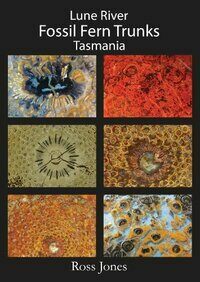This Specimen has been sold.
2" Petrified Fern (Osmundacaulis) Trunk Slice - Tasmania
This unique specimen was part of the was part of the Ross Jones collection. He authored the stunning book "Lune River Fossil Fern Trunks of Tasmania"
This is a beautiful, thin slice of a fossil fern trunk of the species Osmundacaulis griggsii. It was collected from the Lune River in Tasmania and has been sliced thin and encapsulated in a polished clear epoxy. This presentation of the fossil allows for visualization of the fascinating internal cell structures of the fern's trunk, which can be viewed in more detail under magnification.
The age of these fern fossils were studied and debated for over four decades. Based on the basaltic volcanic deposits that surrounded the volcanic sandstone from which these fossils were found, paleobotanists believed that these Lune River flora thrived through the early Cenozoic Era (65 to 1.8 million years ago) and could be dated no older than that. In the 1980s, the interest of these fern fossils grew following donations of the material for further study.
Lack of information regarding their source stratigraphy shifted studies in favor of morphology comparisons of fern fossils from other continents. These studies brought rise to the possibility that the fern fossils could have actually been much older and likely existed around the middle of the Mesozoic Era, roughly 145 million years ago. With this and a combination of isotopic measurements of zircons in the volcanic sandstone deposits that host these flora, it was concluded that the ferns/flora existed about 182 million years ago, dating as far as the early Jurassic.
Studies of very similar Jurassic-aged igneous rocks found in South Africa and Antarctica further confirmed the age of these fern fossils. When these igneous rock formations were first formed, the super-continent Gondwana was beginning to separate. Australia, South Africa, and Antarctica were all in the same general area, explaining why these similar igneous rocks were found on completely different portions of the earth.
Lack of information regarding their source stratigraphy shifted studies in favor of morphology comparisons of fern fossils from other continents. These studies brought rise to the possibility that the fern fossils could have actually been much older and likely existed around the middle of the Mesozoic Era, roughly 145 million years ago. With this and a combination of isotopic measurements of zircons in the volcanic sandstone deposits that host these flora, it was concluded that the ferns/flora existed about 182 million years ago, dating as far as the early Jurassic.
Studies of very similar Jurassic-aged igneous rocks found in South Africa and Antarctica further confirmed the age of these fern fossils. When these igneous rock formations were first formed, the super-continent Gondwana was beginning to separate. Australia, South Africa, and Antarctica were all in the same general area, explaining why these similar igneous rocks were found on completely different portions of the earth.
SPECIES
Osmundacaulis griggsii
LOCATION
Lune River, Tasmania
SIZE
2 x 1.5"
CATEGORY
SUB CATEGORY
ITEM
#106656
We guarantee the authenticity of all of our specimens.
 Reviews
Reviews













